| # | Title | Year | Place | Materials | Measurements | Practice / Format | Together With | Keywords | Weblinks |
| 10 | Three Earths | 2022 / 2023 | Gwarna cementery, Gwarna Street and Konstytucji 3 Maja Square, Wrocław, Poland | Earth Pigments, Pit Lime | Gwarna Street and Konstytucji 3 Maja Square, Wrocław, Poland | site-specific work | THE URBAN MEMORY FOUNDATION | 18th century Jewish cemetery, remembrance, boundaries, non-invasive, marking | Urban Memory Foundation |
Three Earths
THREE EARTHS marks two historical boundaries of the now-destroyed 18th century Jewish cemetery on Gwarna-street in Wrocław (formerly Claassenstraße in Breslau). On Gwarna-Straße the work marks the portion of the cemetery wall from 1908 that is still standing. By turning one’s attention to the wall, we simultaneously turn our attention to the elevated cemetery behind it, where unmarked human remains are still buried to this day. Tennis courts and a gymnasium have been constructed on the grounds. On Konstytucji 3 Maja square, which forms the other end of the cemetery, THREE EARTHS marks the ground where the boundaries of the most outer edge of the historical cemetery once stood. In doing so, the work points to the original size of the cemetery, whose boundaries extend well beyond the streets and housing blocks of the city in its present form.
One of the central premises for this work was to work in an ecologically non-invasive way. As such, I chose to work with natural earth pigments whose color and tone are present in the ground in Poland and the surrounding region. Through this twin connection between the selection of materials and the cemetery as a piece of land where human remains are still buried, an organic image emerged that was also embedded within the city. I chose pit lime as the binder for the pigments in order to completely avoid the use of acrylic or other artificial and poisonous materials. The pit lime allows for the pigments to slowly wear away and dissipate over time by way of people’s steps, rain and snow without harming the groundwater.
Because various parties have intersecting interests in this plot of land, THREE EARTHS was – and continues to be – a political balancing act in the city. It was possible to realize due to the use of non-invasive techniques and natural, non-harmful materials. By way of this temporary work, the idea is to stimulate public thought and discourse on permanent ecologically sustainable spaces of remembrance in the city. In 2023 the work was renewed – a fact that already points to its success and potential.
Alongside the ecological focus, THREE EARTHS is oriented around the three thematic points: 1) the cemetery grounds still containing human remains and being, at the same time, an object of land speculation, 2) the Halakhah (Jewish religious law) that stipulates drawing a distinction between cemeteries and places where daily life takes place - and as such explicitly marking a distinction between these two spaces, 3) the Jewish law stating the necessity of keeping the peace of the dead for eternity.
The work, THREE EARTHS, marks the boundaries of – and names – the Gwarna cemetery for the first time since World War II.
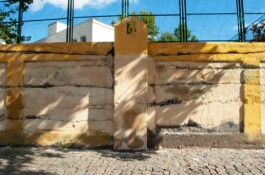
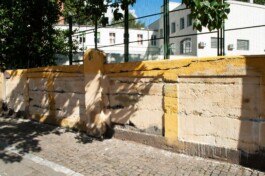
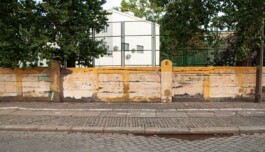
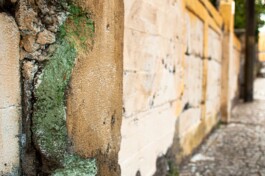
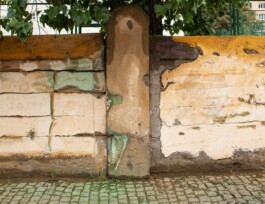
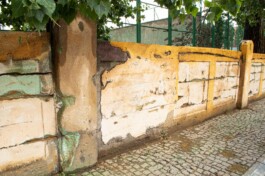
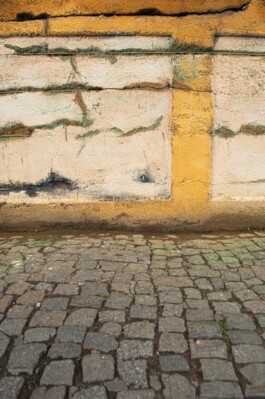
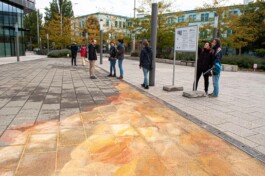
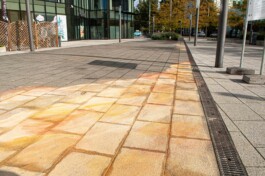
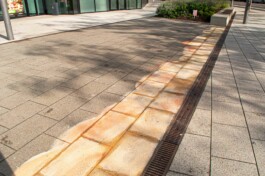
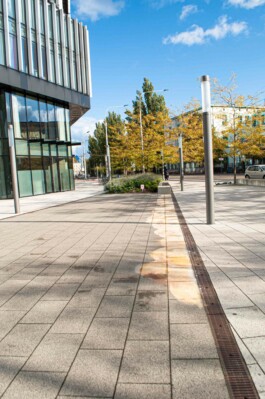
Three Earths
THREE EARTHS markiert zwei historische Außengrenzen des zerstörten, Jüdischen Friedhofs aus dem 18. Jahrhundert an der Gwarna-Straße (ehemalige Claassenstraße in Breslau) in Wrocław. In der Gwarna-Straße markiert die Arbeit den noch stehenden Teil der Friedhofsmauer von 1908. Sobald man auf die Mauer schaut, wendet man sich auch dem erhöhten, dahinter liegenden Friedhof zu, auf dem bis heute unmarkierte menschliche Überreste begraben sind. Auf dem Gelände sind Tennisplätze errichtet worden und eine Sporthalle. Auf dem Platz Konstytucji 3 Maja, der das andere Ende des Friedhofs bildet, markiert THREE EARTHS auf dem Boden den äußeren Rand des Friedhofs und weist so auf die ursprüngliche Größe des Friedhofs im Stadtbild hin, die sich über die heutigen Straßen und Häuserblöcke hinweg zieht.
Eine der Prämissen für diese Arbeit war, ökologisch nicht invasiv zu arbeiten. Dafür wählte ich natürliche Erdpigmente, die in ihren Farbigkeiten in den Böden Polens und darüber hinaus vorkommen. Durch diese doppelte Verbindung in der Auswahl des Materials und des Friedhofs als Erde, in der die menschlichen Überreste liegen, entstand ein organisches Bild, das sich in das Stadtbild legte. Als Bindemittel, das die Erden hält, wählte ich Sumpfkalk, um komplett auf Acryl oder andere künstliche oder giftige Stoffe zu verzichten. Der Sumpfkalk lässt auch zu, dass die Pigmente im Laufe eines Jahres durch den Abrieb von Schritten, Regen und Schnee langsam abgetragen werden und verschwinden, ohne das Grundwasser zu schädigen.
Diese Arbeit war und ist aufgrund der verschiedenen Interessen an dem Boden ein Politikum im Stadtraum, sie war möglich durch das nichtinvasive Verfahren und die Nutzung von natürlichen, nicht schädlichen Materialien. Die Idee ist, durch diese temporäre Arbeit ein öffentliches Nachdenken und Gespräch über permanente, ökologisch nachhaltigen Ort des Gedenkens im Stadtraum anzuregen.
Die Arbeit wurde 2023 erneuert, was für einen ersten Erfolg spricht.
Die drei thematischen Eckpunkte, neben dem ökologischen, an denen ich mich für THREE EARTHS orientiere sind: der Friedhofsboden als Spekulationsobjekt, in dem menschliche Überreste liegen. Die Halacha (das jüdische Religionsgesetz), die vorschreibt, eine Unterscheidung festzulegen zwischen einem Friedhof und den Orten, an denen das alltägliche Leben stattfindet, und somit die Grenzen der beiden Bereiche zu markieren. Die Vorschrift, im Judentum die Totenruhe für die Ewigkeit zu gewähren.
Die Arbeit THREE EARTHS ist die erste Markierung des Friedhofs im Stadtraum seit dem Zweiten Weltkrieg.











| # | Title | Year | Place |
| 10 | Three Earths | 2022 / 2023 | Gwarna cementery, Gwarna Street and Konstytucji 3 Maja Square, Wrocław, Poland |
| Materials | Measurements |
| Earth Pigments, Pit Lime | Gwarna Street and Konstytucji 3 Maja Square, Wrocław, Poland |
| Practice / Format | Together With |
| site-specific work | THE URBAN MEMORY FOUNDATION |
| Keywords | Weblinks |
| 18th century Jewish cemetery, remembrance, boundaries, non-invasive, marking | Urban Memory Foundation |
Three Earths
THREE EARTHS marks two historical boundaries of the now-destroyed 18th century Jewish cemetery on Gwarna-street in Wrocław (formerly Claassenstraße in Breslau). On Gwarna-Straße the work marks the portion of the cemetery wall from 1908 that is still standing. By turning one’s attention to the wall, we simultaneously turn our attention to the elevated cemetery behind it, where unmarked human remains are still buried to this day. Tennis courts and a gymnasium have been constructed on the grounds. On Konstytucji 3 Maja square, which forms the other end of the cemetery, THREE EARTHS marks the ground where the boundaries of the most outer edge of the historical cemetery once stood. In doing so, the work points to the original size of the cemetery, whose boundaries extend well beyond the streets and housing blocks of the city in its present form.
One of the central premises for this work was to work in an ecologically non-invasive way. As such, I chose to work with natural earth pigments whose color and tone are present in the ground in Poland and the surrounding region. Through this twin connection between the selection of materials and the cemetery as a piece of land where human remains are still buried, an organic image emerged that was also embedded within the city. I chose pit lime as the binder for the pigments in order to completely avoid the use of acrylic or other artificial and poisonous materials. The pit lime allows for the pigments to slowly wear away and dissipate over time by way of people’s steps, rain and snow without harming the groundwater.
Because various parties have intersecting interests in this plot of land, THREE EARTHS was – and continues to be – a political balancing act in the city. It was possible to realize due to the use of non-invasive techniques and natural, non-harmful materials. By way of this temporary work, the idea is to stimulate public thought and discourse on permanent ecologically sustainable spaces of remembrance in the city. In 2023 the work was renewed – a fact that already points to its success and potential.
Alongside the ecological focus, THREE EARTHS is oriented around the three thematic points: 1) the cemetery grounds still containing human remains and being, at the same time, an object of land speculation, 2) the Halakhah (Jewish religious law) that stipulates drawing a distinction between cemeteries and places where daily life takes place - and as such explicitly marking a distinction between these two spaces, 3) the Jewish law stating the necessity of keeping the peace of the dead for eternity.
The work, THREE EARTHS, marks the boundaries of – and names – the Gwarna cemetery for the first time since World War II.











Three Earths
THREE EARTHS markiert zwei historische Außengrenzen des zerstörten, Jüdischen Friedhofs aus dem 18. Jahrhundert an der Gwarna-Straße (ehemalige Claassenstraße in Breslau) in Wrocław. In der Gwarna-Straße markiert die Arbeit den noch stehenden Teil der Friedhofsmauer von 1908. Sobald man auf die Mauer schaut, wendet man sich auch dem erhöhten, dahinter liegenden Friedhof zu, auf dem bis heute unmarkierte menschliche Überreste begraben sind. Auf dem Gelände sind Tennisplätze errichtet worden und eine Sporthalle. Auf dem Platz Konstytucji 3 Maja, der das andere Ende des Friedhofs bildet, markiert THREE EARTHS auf dem Boden den äußeren Rand des Friedhofs und weist so auf die ursprüngliche Größe des Friedhofs im Stadtbild hin, die sich über die heutigen Straßen und Häuserblöcke hinweg zieht.
Eine der Prämissen für diese Arbeit war, ökologisch nicht invasiv zu arbeiten. Dafür wählte ich natürliche Erdpigmente, die in ihren Farbigkeiten in den Böden Polens und darüber hinaus vorkommen. Durch diese doppelte Verbindung in der Auswahl des Materials und des Friedhofs als Erde, in der die menschlichen Überreste liegen, entstand ein organisches Bild, das sich in das Stadtbild legte. Als Bindemittel, das die Erden hält, wählte ich Sumpfkalk, um komplett auf Acryl oder andere künstliche oder giftige Stoffe zu verzichten. Der Sumpfkalk lässt auch zu, dass die Pigmente im Laufe eines Jahres durch den Abrieb von Schritten, Regen und Schnee langsam abgetragen werden und verschwinden, ohne das Grundwasser zu schädigen.
Diese Arbeit war und ist aufgrund der verschiedenen Interessen an dem Boden ein Politikum im Stadtraum, sie war möglich durch das nichtinvasive Verfahren und die Nutzung von natürlichen, nicht schädlichen Materialien. Die Idee ist, durch diese temporäre Arbeit ein öffentliches Nachdenken und Gespräch über permanente, ökologisch nachhaltigen Ort des Gedenkens im Stadtraum anzuregen.
Die Arbeit wurde 2023 erneuert, was für einen ersten Erfolg spricht.
Die drei thematischen Eckpunkte, neben dem ökologischen, an denen ich mich für THREE EARTHS orientiere sind: der Friedhofsboden als Spekulationsobjekt, in dem menschliche Überreste liegen. Die Halacha (das jüdische Religionsgesetz), die vorschreibt, eine Unterscheidung festzulegen zwischen einem Friedhof und den Orten, an denen das alltägliche Leben stattfindet, und somit die Grenzen der beiden Bereiche zu markieren. Die Vorschrift, im Judentum die Totenruhe für die Ewigkeit zu gewähren.
Die Arbeit THREE EARTHS ist die erste Markierung des Friedhofs im Stadtraum seit dem Zweiten Weltkrieg.










